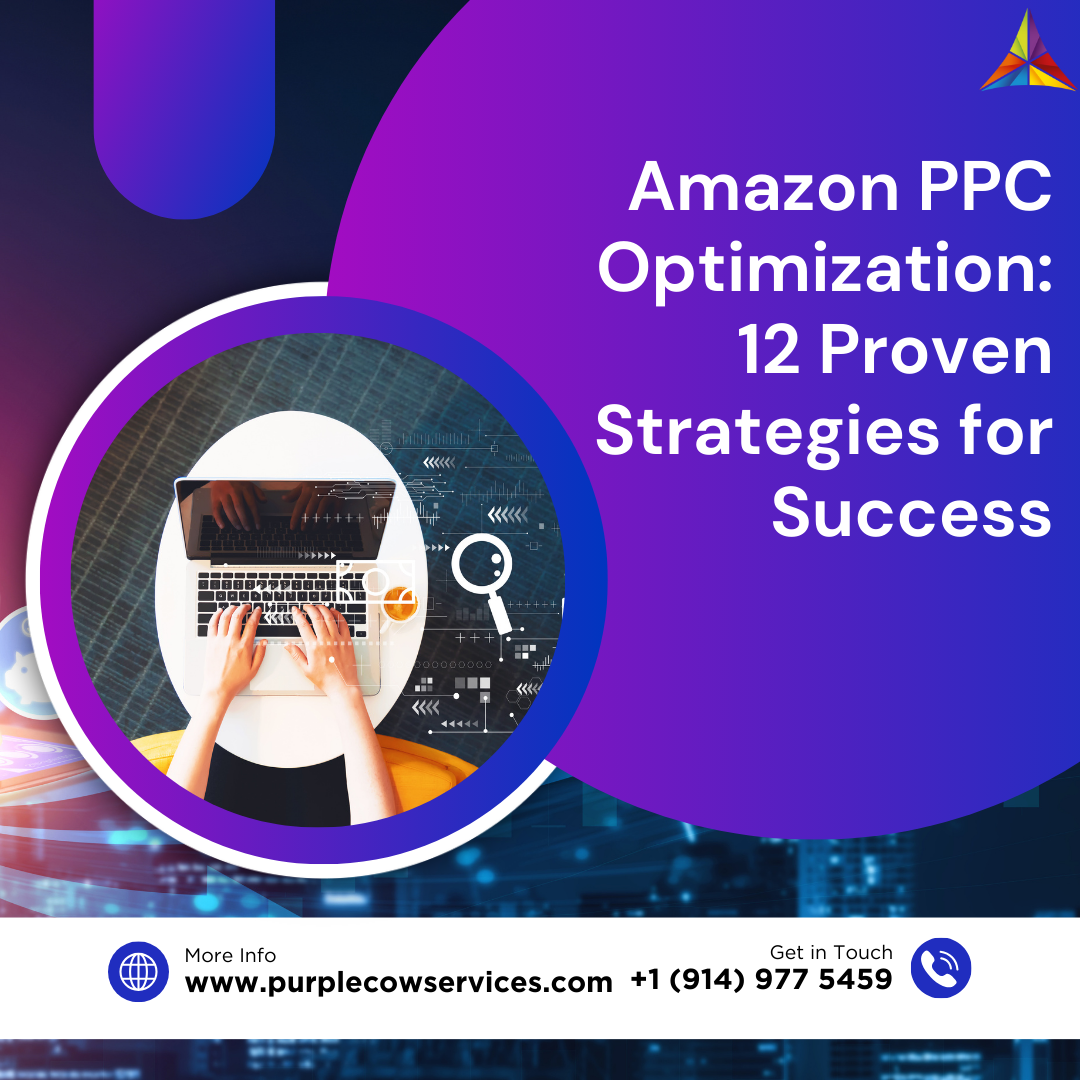In the ever-evolving realm of eCommerce, Amazon PPC (Pay-Per-Click) has become a critical tool for businesses seeking to expand their customer base and boost revenues. With millions of potential customers within reach, competition is fierce.
Share This Story, Choose Your Platform!
The battle for visibility and sales intensifies, especially with the rise of Amazon FBA aggregators and deep-pocketed corporations investing heavily in advertising. As a result, the average Amazon Cost-Per-Click (CPC) rose from $0.76 in 2020 to $0.98 in 2022, with Amazon’s advertising revenue reaching a staggering $37.7 billion.
In this fiercely competitive landscape, effective Amazon PPC optimization is imperative for sellers to thrive. This article delves into 12 specific and actionable strategies to optimize Amazon advertising campaigns and navigate this dynamic market successfully.
Discover the Key to Amazon PPC Optimization
A Glimpse into the Article:
Setting clear business and campaign goals, structuring campaigns effectively, optimizing product listings with relevant keywords, harvesting high-performing keywords from auto-campaigns, using negative targeting to eliminate wasted ad spend, calculating target ACoS (Advertising Cost of Sales) and optimizing bids, allocating higher budgets for peak conversion times, bidding aggressively on alternative keywords, leveraging top-of-search placement and branded keywords, selecting the right products for Brand ads, bidding aggressively on high-converting products in product targeting campaigns, running product targeting campaigns for listings with external traffic.
Why Amazon Advertising Optimization Matters
Amazon advertising optimization matters significantly as it directly impacts your eCommerce success. Effective optimization ensures your advertising budget delivers the highest ROI by targeting the right audience, reducing wasteful spending, and maximizing sales. In the competitive Amazon marketplace, optimization helps you stay ahead by improving brand visibility, staying cost-efficient, and adapting to market changes swiftly. It also enables data-driven decision-making, allowing you to scale successful campaigns, control costs, and build a sustainable long-term presence on the platform. Ultimately, Amazon advertising optimization is not just a strategy; it’s a necessity for thriving in the ever-evolving eCommerce landscape.
Setting Clear Business & Campaign Goals
In the world of Amazon PPC, having a well-defined sense of direction is paramount. While the primary objective of Pay-Per-Click (PPC) campaigns is undoubtedly to boost sales and return on investment (ROI), it is equally crucial to align these advertising efforts with specific business goals. Whether your aim is to assert dominance in a particular market niche, explore cross-selling opportunities, or bolster brand awareness, having clearly articulated objectives acts as a guiding light. These goals become the compass that steers your campaign strategy in the right direction, ensuring that every ad and keyword choice serves a purpose beyond immediate returns. As you embark on your PPC journey, these goals will keep your efforts focused and strategic.
Structuring Campaigns Effectively
Imagine your PPC campaigns as the architecture of your advertising efforts. Just as a well-structured building reduces confusion and enhances functionality, an organized campaign structure is pivotal for optimal performance. A logical hierarchy in your campaigns minimizes clutter, making it easier to manage and analyze their effectiveness. It starts with the fundamental principle of separating ad campaigns for different products or product categories. By keeping these distinct, you can tailor your approach to each one’s unique needs and target audience. Consistency in naming conventions further streamlines the process, ensuring that campaigns are easily identifiable and their objectives crystal clear. Ultimately, effective campaign structuring paves the way for more efficient management, streamlined decision-making, and improved campaign performance.
Optimizing Product Listings with Relevant Keywords
Within the vast Amazon ecosystem, your product’s discoverability largely hinges on the relevance of its keywords. If your product listings lack sufficient impressions, it’s often indicative of a crucial shortcoming—insufficiently optimized keywords. In such instances, Amazon’s Keyword Research tool emerges as your trusty ally. It helps identify high-performing keywords that closely align with your product’s offerings. Armed with these insights, you can strategically incorporate these keywords into your product titles, descriptions, and bullet points. This optimization not only enhances the visibility of your products but also ensures that your listings resonate with the search intent of potential customers. In essence, optimizing product listings with relevant keywords is the linchpin for improving your products’ discoverability and conversion rates on the platform.
Harvesting High-Performing Keywords
In the dynamic world of Amazon advertising, adapting and evolving are essential to staying ahead. One potent strategy is to harvest high-performing keywords from your auto-campaigns. These keywords have already demonstrated their potential by generating favorable sales outcomes and maintaining a low Advertising Cost of Sales (ACoS). By transitioning these successful terms into your manual campaigns, you capitalize on their proven effectiveness. This approach maximizes conversions while curbing ad spend, a dynamic duo that fuels a more cost-effective and efficient advertising strategy. Thus, the process of harvesting high-performing keywords empowers you to fine-tune your campaigns continually, driving better results in an ever-changing marketplace.
Using Negative Targeting
In the world of Amazon PPC, not all impressions are created equal. High impressions paired with low clicks or a lack of sales can bleed your ad budget dry. To mitigate this, savvy advertisers employ negative targeting. Negative keywords are the gatekeepers of your campaign’s relevance, allowing you to filter out search terms that aren’t aligned with your product or target audience. By eliminating search terms that drain your budget without delivering value, you optimize your campaigns for efficiency. This strategy is akin to pruning a garden, allowing the healthy and productive elements to flourish while removing the weeds that hinder growth. The result? Enhanced campaign effectiveness, reduced wasted ad spend, and a sharper focus on attracting the right audience.
Calculating Target ACoS and Optimizing Bids
In the realm of Amazon advertising, achieving the right balance between ad spend and revenue is an ongoing pursuit. Calculating your target ACoS (Advertising Cost of Sales) serves as a compass in this endeavor. Based on your business goals and profitability targets, the target ACoS guides your bidding strategy. When the actual ACoS exceeds this threshold, it’s time to lower bids for keywords and campaigns that are underperforming, or even consider pausing them to bring the ACoS back in line. Conversely, if your ACoS falls below the target, it’s a signal to consider increasing bids, capturing more traffic, and potentially boosting sales. This dynamic approach to bid management ensures that your advertising efforts remain aligned with your desired outcomes, whether it’s cost control or revenue maximization.
Peak Conversion Time Budgeting
Understanding the rhythm of your customers’ buying patterns is akin to knowing when the waves are highest for surfers. Identifying peak conversion times through careful analysis of sales data empowers you to allocate your ad budget strategically. By increasing your advertising spend during these peak hours, you maximize campaign efficiency and capitalize on the moments when potential customers are most active and receptive. This ensures that your ad dollars are put to their best use, minimizing wastage during less active periods. The result is a campaign budget that’s optimized not just for overall efficiency but for the specific ebbs and flows of your target audience’s shopping behaviors.
Bidding Aggressively on Alternative Keywords
In the dynamic world of Amazon PPC, adaptability is key to staying competitive. When a particular keyword excels in your PPC campaigns and your product ranks well for it, it’s time to bid aggressively on alternative, high-converting keywords. This strategy aims to elevate your product’s visibility in organic search results for these new keywords. It’s akin to broadening your horizons and tapping into additional avenues of potential customers. By bidding aggressively on these new keywords, you can expand your reach and capture more of your target audience, boosting your overall sales and market share.
Leveraging Top-of-Search Placement and Branded Keywords
Maximizing your advertising performance on Amazon often involves leveraging two key strategies: targeting top-of-search placement for high-volume non-branded keywords and utilizing branded keywords. These two approaches cater to different aspects of your advertising goals. Targeting top-of-search placement helps improve brand visibility by ensuring your product appears prominently in relevant search results, increasing the likelihood of attracting potential customers. On the other hand, bidding on branded keywords, which typically have lower CPCs (Cost Per Click) and higher conversion rates, can significantly improve your campaign’s overall Return on Ad Spend (RoAS). These strategies, when used in tandem, create a balanced approach to enhancing both brand presence and campaign performance.
Selecting the Right Products for Brand Ads
Sponsored Brand ads are a powerful tool to showcase your products and brand on Amazon. However, success lies in selecting the right products to feature within these ads. The strategy here involves a three-fold approach. First, feature your best-selling product as the anchor, drawing potential customers with its appeal and popularity. Second, include a product with moderate visibility but a compelling value proposition. This product can serve to expand your audience reach and cater to a broader range of potential customers. Finally, consider incorporating a newly-launched item, which can benefit from the exposure provided by Sponsored Brand ads, helping it gain traction in the competitive Amazon marketplace. By carefully curating the products featured in your Brand ads, you can optimize your campaign’s effectiveness and drive impressive results for your business on Amazon.
Conclusion
Effective Amazon PPC optimization is essential for achieving success in the competitive Amazon marketplace. These strategies will help you maximize ROI, reduce ad spend wastage, and enhance the overall efficiency of your advertising campaigns. To excel in Amazon advertising, consider partnering with experts like SellerApp, who can provide comprehensive advertising strategies and AI-powered PPC management tools. Join the ranks of brands like Philips and Samsung, who’ve experienced significant profit growth with our assistance. Schedule a call with us today and elevate your eCommerce business to new heights.
Unlock Your eCommerce Potential with Purple Cow’s Amazon Advertising Optimization Services! Our expert strategies, from targeted keyword optimization to peak conversion time budgeting, ensure you get the most from your Amazon campaigns. With us, you’ll maximize ROI, reduce wasted ad spend, and achieve sustainable growth. Dominate the marketplace and boost your sales. Partner with Purple Cow today for eCommerce success!
Share This Story, Choose Your Platform!
In This Blog:

















